The Waiting Room
David Wlazlo
In her 1995 essay, ‘The Art Museum as Ritual’, art historian Carol Duncan describes how visitors to art galleries engage in a kind of ritual by visiting these spaces. In discussing the act of physically attending—including the intention to visit as well as the standards of behaviour adopted while visiting—Duncan writes that art museums “enable individuals to achieve liminal experience—to move beyond the psychic constraints of mundane existence, step out of time, and attain new, larger perspectives.”
This liminal experience is ours when we visit an art gallery or museum and is akin to the phrase “once upon a time” that begins so many stories. Everything I recount after saying once upon a time is set aside, removed from the mundane and rendered liminal. The term “liminal” is often described as “being in-between” something or other, but it can also mean “being set aside” or bracketed off from the normal existence we experience every day when we brush our teeth or put something down on the table, for example. These actions in themselves aren’t anything to do with art, but place them within the once upon a time of the art gallery and all of a sudden they present the potential to transform our perspectives on the world with the same force as a moralising fairy tale. It goes without saying, of course, that you have first to be allowed out of your house.
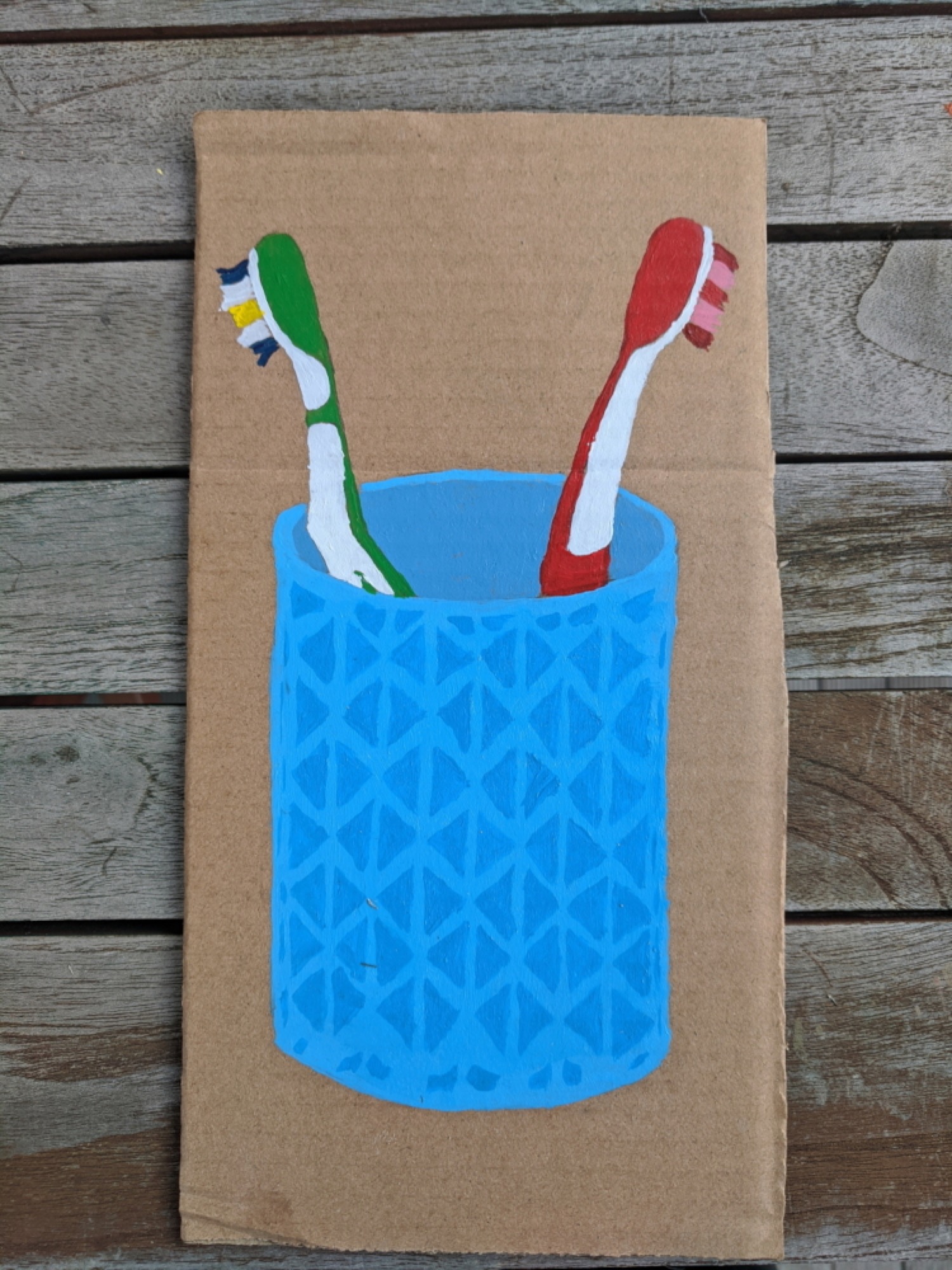
The recent online exhibition at VCA Artspace takes the idea of the liminal as its cue. The Waiting Room is a large group show of 28 first-year painting students who are all stuck at home experiencing the new kind of university: art school delivered remotely. The students—outside the university and waiting for restrictions to be lifted—are bracketed off and held back from their immersion into the liminal once upon a time of art school. They’re waiting, that is, to be led through to another liminal situation where art is bracketed off from daily life. What is so interesting about their work is how it responds to the broad collectively shared experiences of lockdown and everyday life. It is a slowed descent (or ascent if you prefer) into the usual once upon a time of professional art fairy tales and art-historical nursery rhymes.
The exhibition is hosted on an Instagram page @vcaartspace and is curated by three of the students: Ignatz Cady Freer, Lili Ward and Will Mcintyre. The gallery shifted to this online approach after restrictions shut the school down. The IG page links to a large, downloadable zip file containing an HTML site with images, artist’s statements and video excerpts. The download itself is the exhibition’s own locally hosted website, loading up in a browser but not connected to the internet. It’s a pretty interesting approach, as usually you would think that an online exhibition format would be either one or the other: either just host the whole thing on IG or fork-out and pay for a website. The hybrid IG-Downloadable file adds a few extra steps, and the file size is 768MB, so it all feels a bit hefty and meaningful in these effervescently virtual times. Significantly, the download almost replaces the ritual intentionality of a physical gallery visit by bracketing the exhibition off from the general buzz of IG and the broader internet: it is a reduced form of ritual attendance. It’s as if, somehow, the preciousness of bandwidth and hard-drive space stands in for the ritual of reverential attention in a real life gallery.
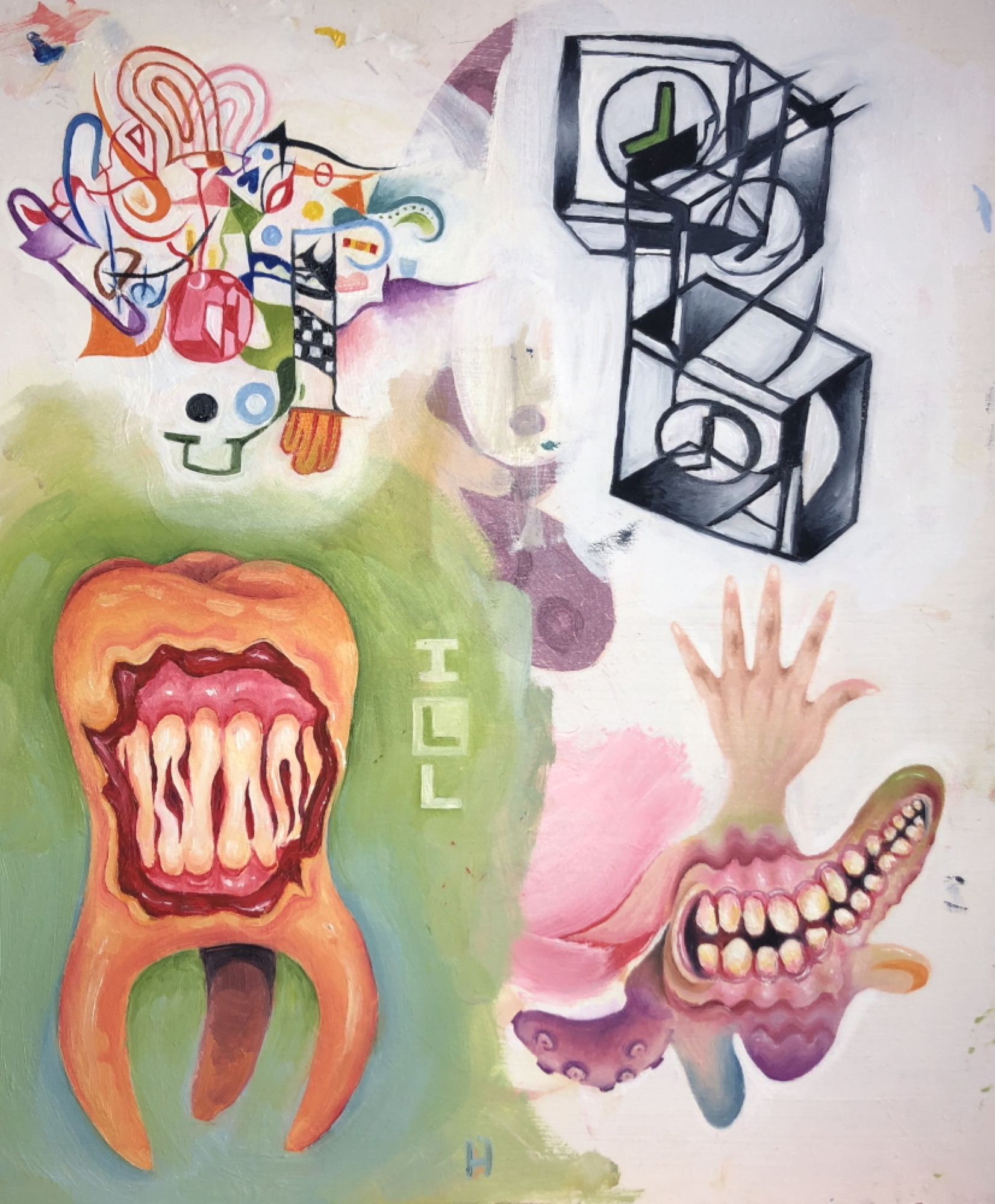
It’s not easy to characterise the work of these 28 artists. Partly this is because they are students, and you don’t want to interfere too much with early artistic development. But it is also because they are just so numerous. The artists are drawn from the first-year painting class, and while some of the works betray the trappings of early-student work, most are refreshing and interesting examples of personal expression and response to the historical circumstances of the year. I’m going to try to write about all of these artists in turn, drawing connections where I can. Mostly though, I want to write about all of them because if I was stuck at home in first year and some old bastard wrote about the show I was in and didn’t mention me, I’d be pissed.

The paintings of a few artists show a strange obsession with teeth and dental hygiene. Brienna Heath, for example, has painted a large diptych showing a jawbone, removed molars, toothbrush and paste. 1 Tooth, 2 Teeth, 3 Teeth, Fuck! (2020) is a Rorschach-type butterfly painting where one side of the diptych has been painted and then squished onto the other side with “Minty Fresh” and “Anxious Bitch” in printed lettering. Hannah Rose’s painting Collection (2020) also has some painful-looking teeth-within-teeth alongside some Cubist/Surrealist clocks. These Léger-esque paintings have the lightness and frivolity of idle doodling and they seem to avoid a lot of the weight of their art-historical references. Maybe that comes later. Emily Caudry has also taken up the dental theme with two paintings of isolated and arranged teeth, although these still have the gums. Dividing Chompers and Big Chompers (2020) have a gridded or striped overall appearance, the yellowy-white teeth appearing like seats in a dark red theatre. Ollie Boyce has also painted a pair of toothbrushes on cardboard. Untitled (2020) has a red and green toothbrush held in a blue cup. The brushes appear to face away from each other, as if they had faces, but this is no metaphor as Boyce explains in a statement: the only consistency in their life this year has been teeth-brushing and playing Animal Crossing.
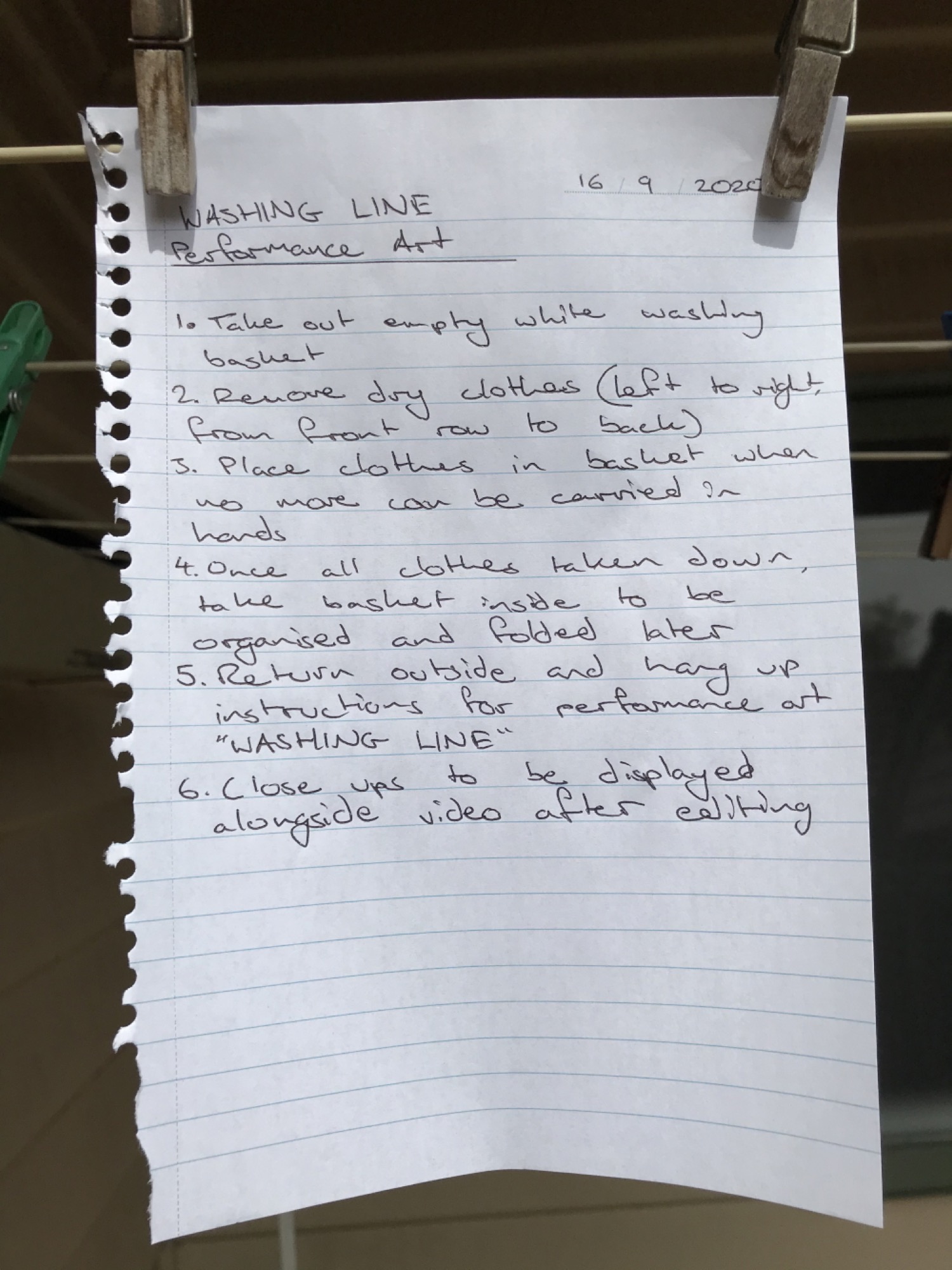
The significance of teeth, then, may simply be the injunction to brush them one-to-three times daily. These artists seem to be coding and sequencing everyday life (what we sometimes unironically call, within the liminal, The Everyday). Aspects of life are examined, cared for and taken up as items of reflection and modification. Patrick Pettenon employs this approach in Washing Line (2020), a performance video that provides instructions on bringing in the washing and then shows a video of the artist doing just that. Nicholas Currie also raises these issues in Shame (2020), a painting about being interrupted masturbating. Currie explains: “Being home there is not a lot to do except to explore yourself mentally and physically.” Take that, mindfulness.

George Manioudakis’ abstract painting Frequency (2020) also explores freedom and liberated expression, as home studio constraints limit painting techniques. A statement accompanying the work describes “the pressure of not getting paint on the floorboards” and I can almost hear the parents now wishing George took a different, cleaner degree (dentistry perhaps?). Remember, most rental leases prohibit the use of blu-tack, and now the studio is meant to calmly move home? Like the habits of the everyday, the restraints of domesticity loom large.
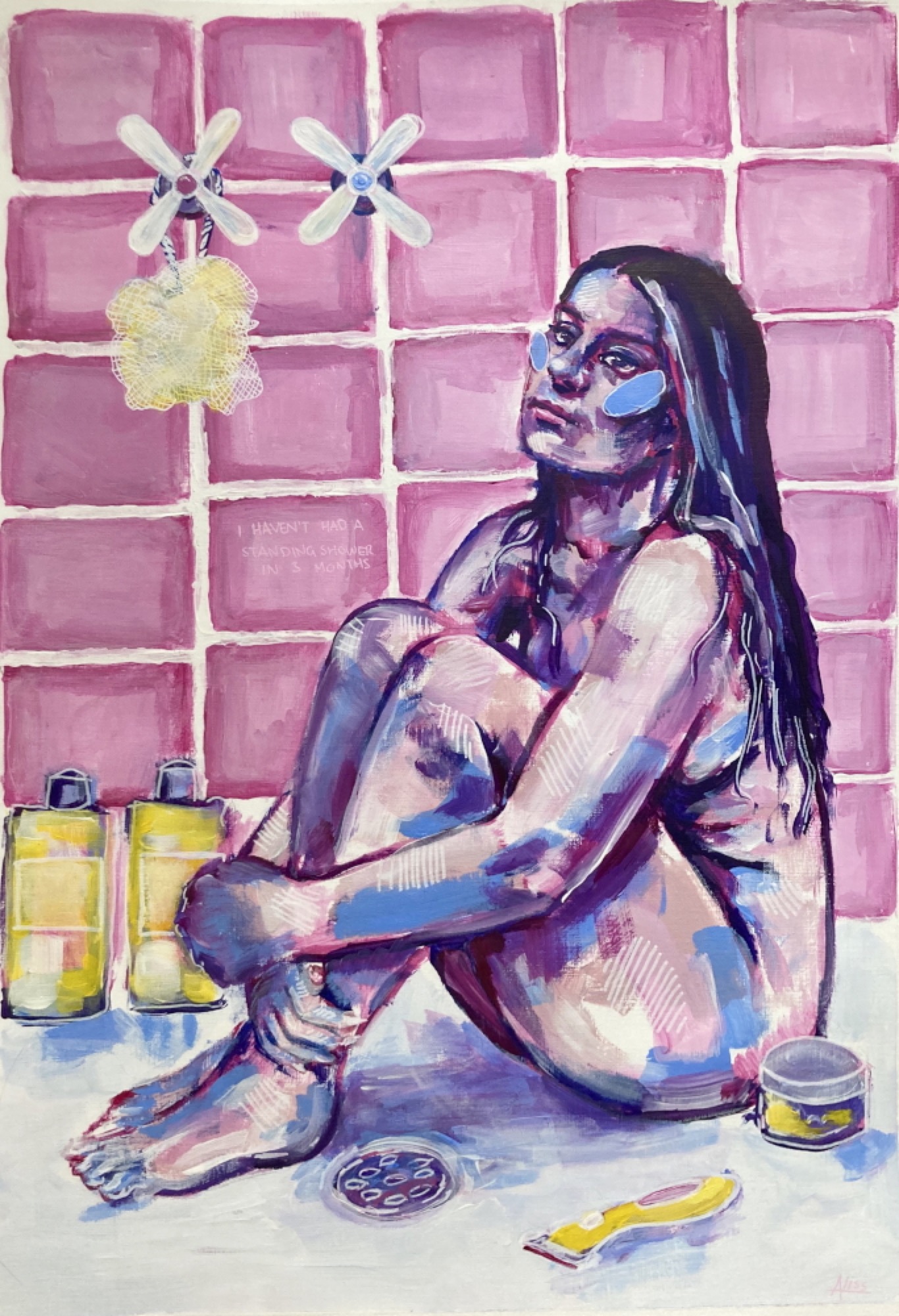
Likewise restricted, Aliss Rigby has painted a portrait of a young woman sitting naked on the shower floor. Typically, the naked-person-crouched-on-the-floor trope suggests an over-abundance of youthful angst, but here I can’t help feel that I HAVEN’T HAD A STANDING SHOWER IN 3 MONTHS (2020) is really painted in the only place in the house Rigby can get enough privacy to do some DIY life drawing to explore the painting’s reduced palette. But what is the artist trying to tell us about? Maybe the title helps?

Other artists seem to step through into the pictorial space and spend a lot of time with a technically-minded realism. For example, Grace Stevenson’s realist figures within pizza boxes suggest this kind of internal focus, both literally (they are boxes after all) and within the practical focus of detailed and technical work. Open Up 2 (2020) shows a bored and/or dazed seated figure staring out of the open and flattened pizza box. The striped background is a little psychedelic, and the figure-ground relations are set off nicely by the left box showing only a change in pattern to indicate the foreground. They look like they were created “in the zone”, perhaps as a devotional act to fast food. Delivered and takeaway food has taken on a new meaning for many in recent months when every social interaction seems to have extra significance. Supporting local businesses, dark kitchens, the gig economy: it’s a surprisingly loaded idea. Maybe these daily realities of late-capitalism are Stevenson’s reality? It is a little hard to know for sure.

Claire Price is also deep in concentration with the painting Love Language (2020), an almost hyper-real painted close-up of a face with fingers pointing out cue points of body language. In a statement, the artist describes how lockdown has changed ideas of bodily sensuality and communication. To be at home is, for Price, to be with a constantly changing and updating identity rather than a static holding pattern patiently waiting for “normality” to return. What is interesting about these approaches is the way that deep reflection is facilitated by isolation and restriction. Is there a form of monasticism going on here?

Enya Hu has also touched on the idea of social withdrawal as a form of monasticism in the painting Decision Making (2020). The work shows a person in the classic “thinking” pose (à la Rodin) sitting outside a cryogenic stasis chamber. The question the artist poses is deeply philosophical: is it better to sit frozen outside of suffering and defrost after the virus, or is there some kind of transformative “the-journey-is-the-destination” experience value to be had through all this? (When I was growing up, the strange behaviour of some older people was explained away by the fact that they lived through the Great Depression. I wonder what thirty years is going to say about our developing nervous tics? An aversion to video conferencing in place of a hoarding of potentially useful objects and string? Perhaps only those untouched by this year’s events will be the weirdos.)

Perhaps also taking the religious connotations of isolation on board, Sarah Kottek’s figures occupy a cloudy pictorial space with lotus flowers and hand-gestures or mudras seeming to float in and out of the cosmic abstraction. The earthy insects of Leaf Litter (2020) add to the artist’s preoccupations with religious tropes by including a centipede and praying mantis. The leaves and bugs and the pillowy-lips of the faces repeat and seem to become detached from any idea of a face. The attachment to the face as form persists, the features are all in normal compositional relation to one another. But there is the promise of decomposition in the soil.

Perhaps without the same level of overt mystic potential, the nevertheless profound work of Shaarn Pateman shows a repeated image of a man’s face as an attempt to plumb the abyssal depths of other people’s minds. The format of Man on a Train (2020) suggests the well-worn Warholian argument about celebrity, surface and grid-like repetition—a face, almost a mugshot, is repeated across a surface. However, the arguments about pop art and celebrity are not so simple when your image is of a “normal” person in a white hoodie in “normal” pre-COVID times. Phoebe Haig takes the idea of a face and, unlike Pateman, uses it as a surface and inverts it as a source of potential knowledge. There are so many masks, so many unknown expressions that using the face as a window into a person seems so very old fashioned. Haig’s Untitled (2020) is a beautifully layered interior space with a faceless person on a couch that is a bit reminiscent of David Hockney’s work. The textured painting of Matthew Rajkowski’s Figure no.1 (2020) is also ghostly and faceless. Emma Majstorovic’s esoterically-titled painting ? (2020) has an almost faceless, hollow-eyed figure who seems to be a kind of ghost or spirit in the garden. Bahji Nguyen’s Box Man Alone no. 2 (2020) is a strange painterly monstrous figure with horns, and the artist’s statement describes an interest in panic and perception. Just quietly, I think a lot of people this year share that interest.

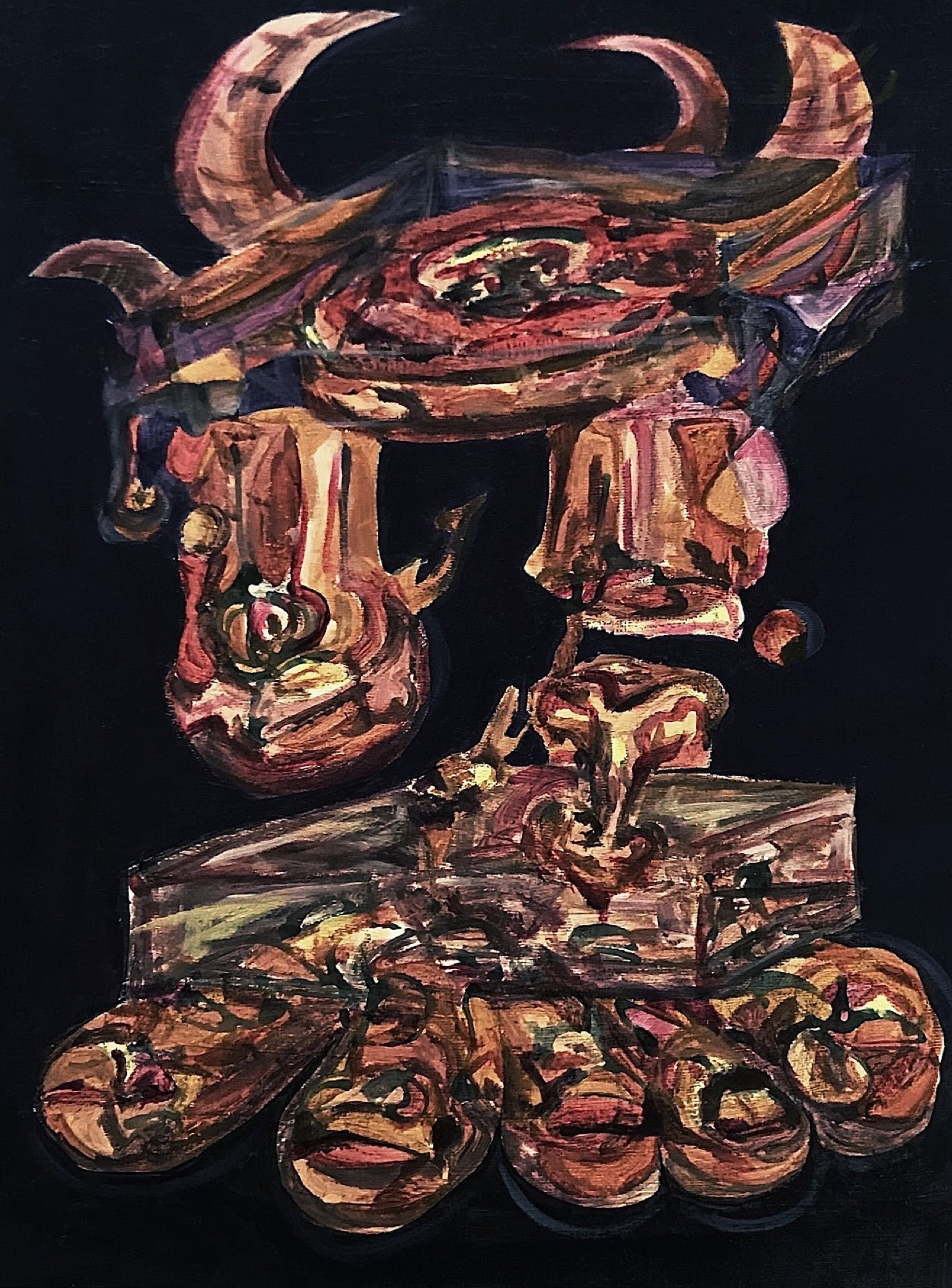
These thoughts of teeth and faceless and monstrous figures seem the darker side of monastic and ritual contemplation, some kind of dark night of the soul. What kinds of transformations are going on in these satellite studios? What if the liminal goes too far, beyond the pale, randomly arranging all and any objects into anything? Can the enveloping embrace of the liminal still be brought back?
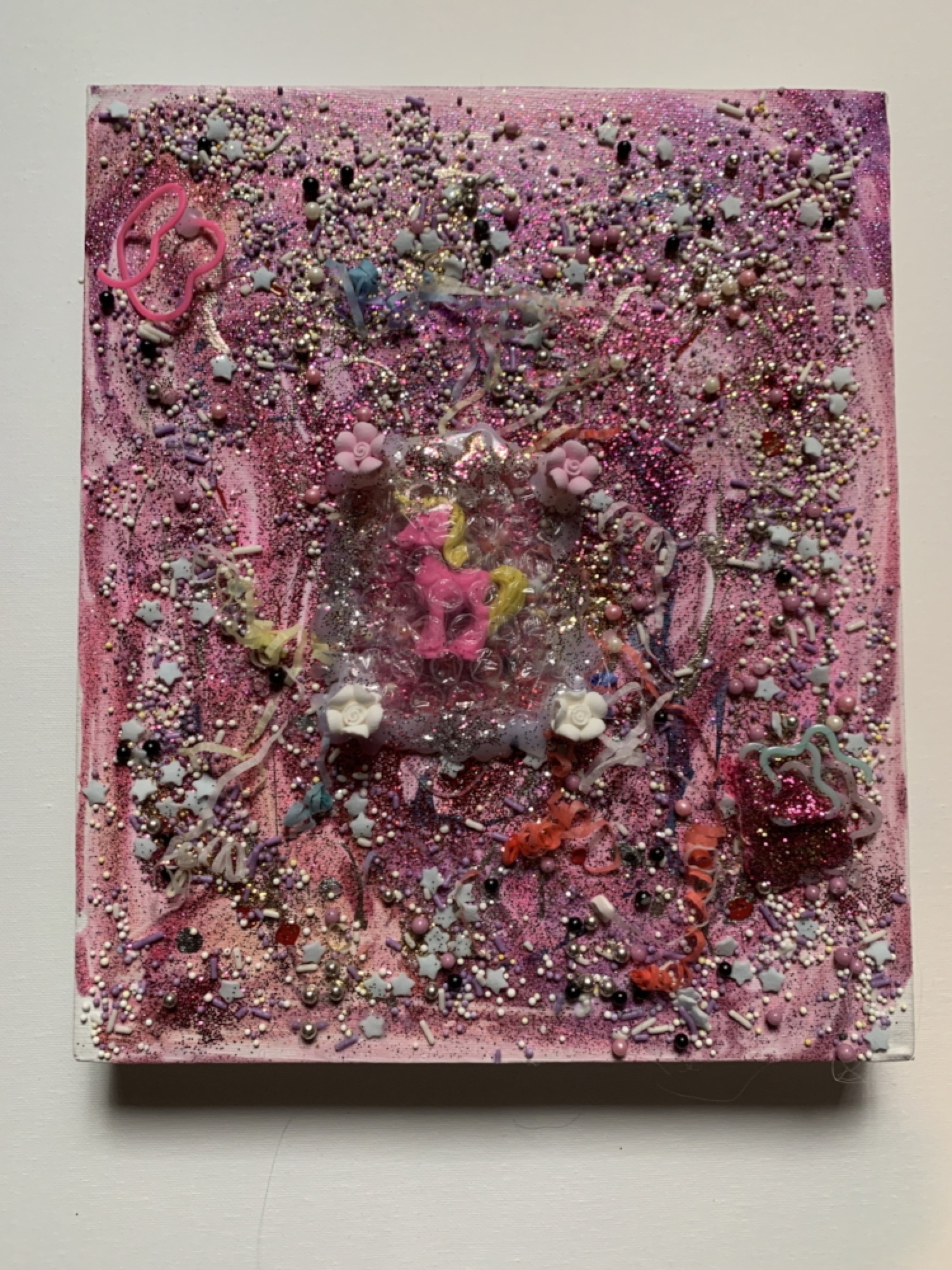
Works by Phoebe Haffenden, Lockie Marley and Marcus Payne all use found objects and materials in combined abstract forms. Broken beer bottles in polyurethane foam, unicorn toys in glittery religious icons and found cardboard shooting targets all become materials for Rauschenberg-y abstractions. Others also draw impetus from modernist painting traditions, such as Vasilika Tsingos’s tonal still lives and domestic windows tagged with the word “paint”, Will Mcintyre’s Untitled abstract crayon drawing and Marcus Horswell’s cryptic Untitled (2020). All of them show an interest in exploring various material traditions of twentieth-century art. Jebediah Costin also develops a concern with the language of national identity drawn from last century’s visual traditions with an eye to their populist re-emergence. Three Flags (2020) combines the US and the Australian flag with the word “poem” and seems to invite a consideration of the national on a symbolic and aesthetic level.

Another exploration of symbolic visual language is in Loughie Kemp’s installation Memorial (2020), a reflection on the fate of gay porn actors from a series of VHS tapes gifted to the artist by a friend. The work is a budget altar in the corner of a room with tea-light candles, an indoor plant, some red lipstick and a projection. The artist states that the work is a reflection on the likelihood that these actors may have died from AIDS-related illnesses. The memorial is rendered less solemn by the painting of an unwell-looking Caspar the Ghost with a sickly phallic tongue. The historical foreshortening of the VHS tapes with the AIDS crisis of the late 70s and 80s is also a bit jarring. I don’t doubt the earnest reflection, yet it seems more an irreverent study of the language of altars and tropes of doom than a memorial.

Ignatz Cady Freer’s work also operates on a kind of gonzo level. In the video work Wake Up My Sweet Prince, It is all Downhill From Here (2020) we see a laptop showing someone sleeping, while a smartphone off to the side scrolls through some kind of weird pig mask fetish images that I’m too old to know about; a ranting Qanon antivaxxer live-streaming bullshit about how Australia is under attack and vaccinations lead to microchipping; and a voice synthesiser reading off pickup lines from phishing emails and bots. Another work by Cady Freer is a series of poly resin garden sculptures of figures oddly dressed and with the occasional penis-shaped candle, and some paintings leaning against the plants in the garden. Penis jokes are almost a traditional practice in art by now, and these nested images hide in pictorial space as a mise en abyme, the same way as those images are nested and layered in the videos.

Lili Ward, like Cady Freer, examines the sender-receiver structure of the internet in the Untitled paintings of CAPTCHA texts on Perspex. These wavy texts that we are asked to interpret on some websites (to prove we are human) are supposedly unreadable by computer algorithms. Ward’s other works suggest an interest in meetings and interactions, relationships and encounters: the works LOCKED GATES I MET AND LIKED (2020) and MUDDY HOLES (2020) explore this idea of meeting, while the triptych painting RADISH (2020) shows a radish and the feet of a “radish receiver”. These paintings explore connectivity as meetings with all aspects of the world, even vegetables and muddy holes. The rhetoric of connection, much elevated by neo-capitalism, has a longer and more nuanced history: there is no need to prove yourself a human before a vegetable patch.

Finally, Isabella Besen’s work shows some photography-based examinations drawn from their experience of the ritual “walk within five kilometres of one’s house”. The video My Neighbour’s Tree (2020) and The Swans I saw at Albert Park Lake (2020) both overlay repeat viewings of the same objects. The movement of the world becomes uncanny and jarringly like a déjà vu. But wait, the world is already like a déjà vu. These streets seem familiar. Didn’t I brush my teeth recently? Haven’t I already lit the candles on this altar to gay porn actors?
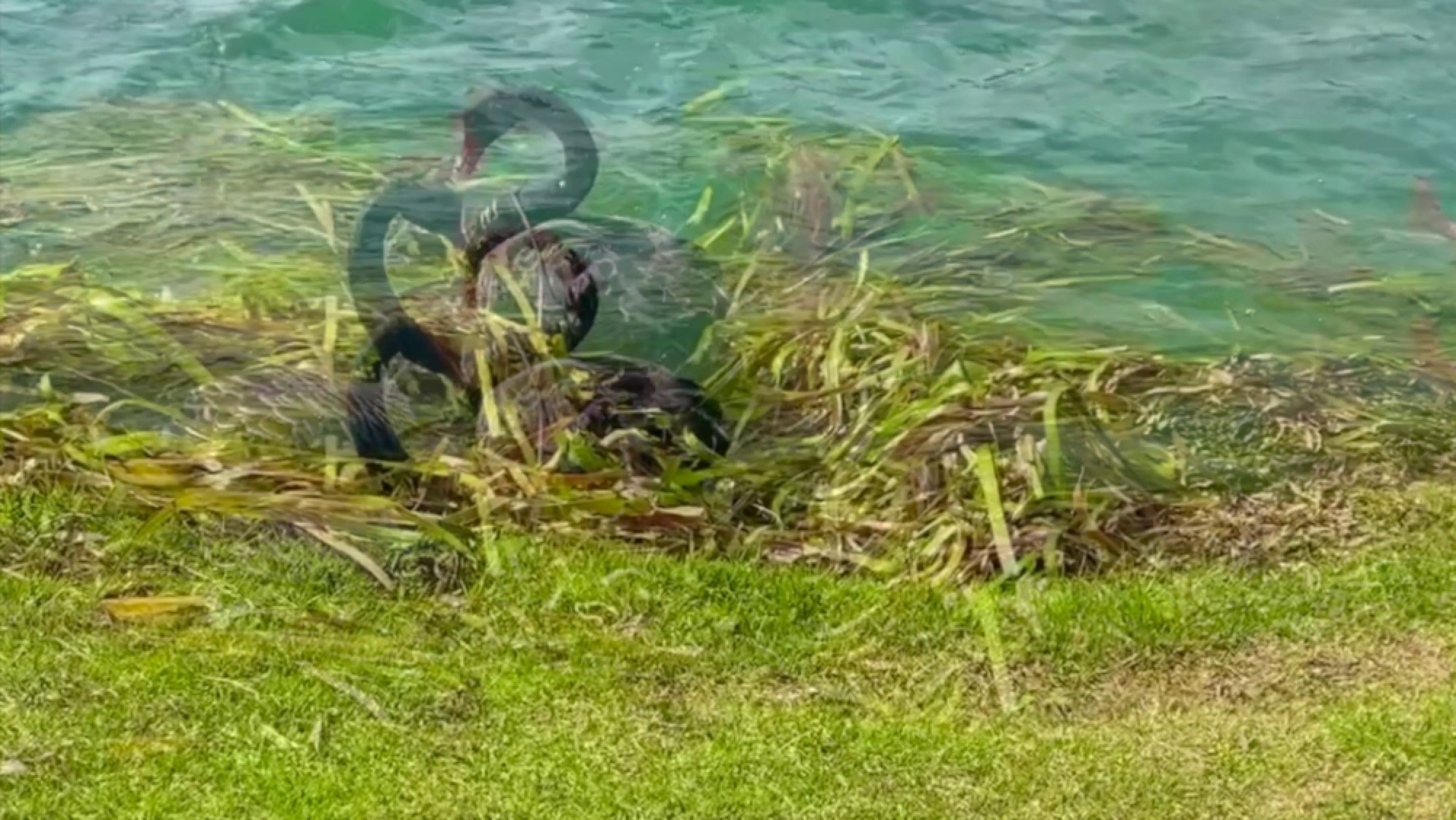
The work in The Waiting Room is a reflection on ritual. Rituals before the ritual of art school, rituals of everyday hygiene, rituals of art practice. So much art and cultural writing done in the COVID situation reflects on the day to day, the mundane situation of writing itself; I’m writing this from my couch, I can see my dog, I’m wearing my slippers, etc. These gestures seem to be a way of searching for the ritual, the once upon a time of the institutions that bracket off the everyday and allow it to grow into the transformative experience we expect from art.
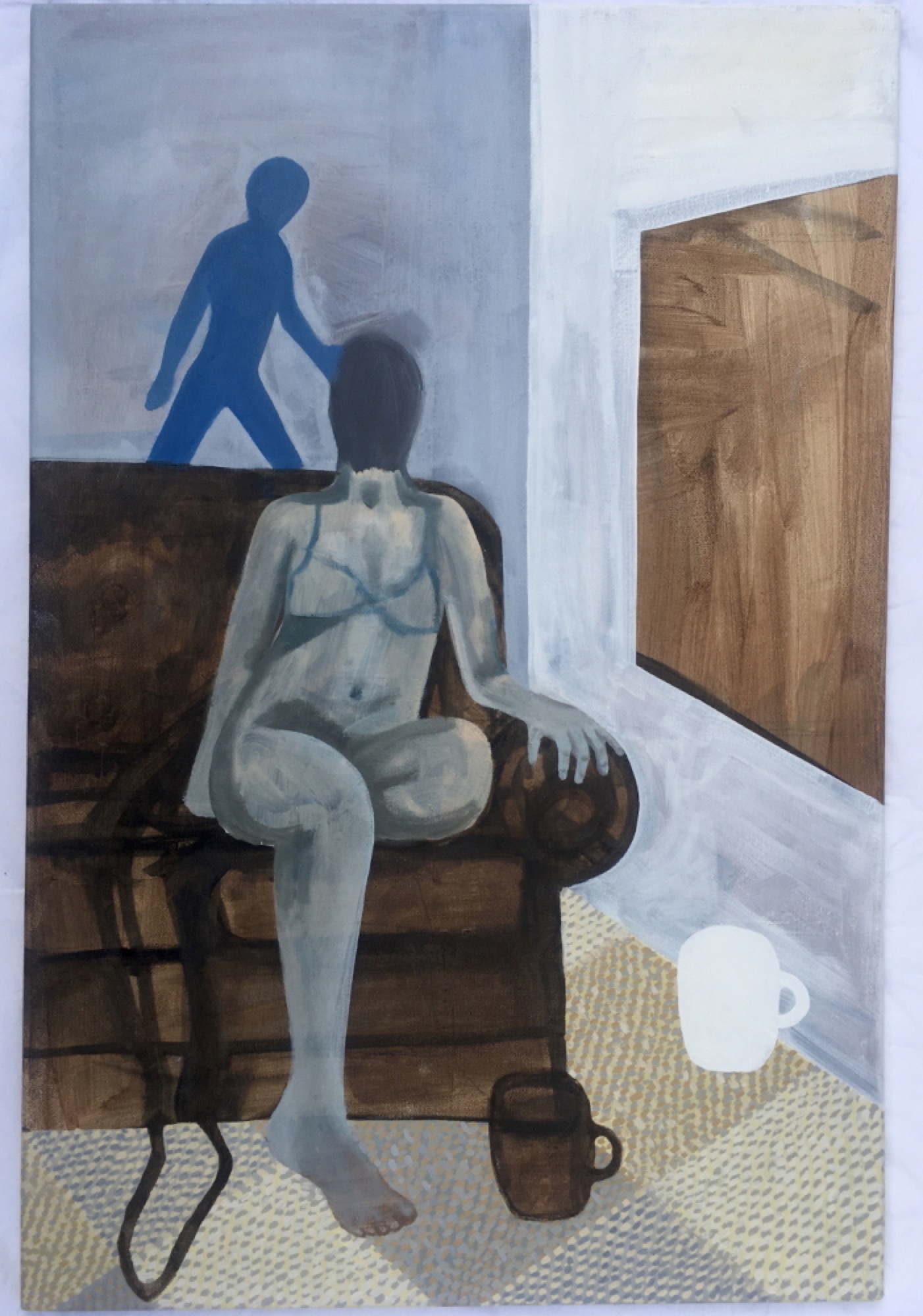
Like most places of liminality, care is needed to ensure that their transformative potential and their power to change perspectives persists. To engage in these rituals is to breathe life and to care for them. The ritual of art school is an induction into these zones of liminality. The real challenge will be for universities to modify the ever-ambivalent relationship between artists and the university-as-corporate-business, only this week further complicated by the Federal government’s higher education bill reforms. Once upon a time, everyone had to stay home and everything had to change. Otherwise, the stories we teach won’t be legible.
David Wlazlo is a writer, artist and farmer who lives and works on Gulidjan and Gadubanud country in South West Victoria.


